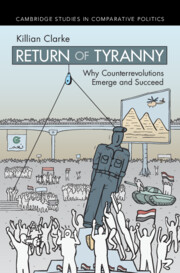Book contents
- Return of Tyranny
- Cambridge Studies in Comparative Politics
- Return of Tyranny
- Copyright page
- Dedication
- Contents
- Figures
- Tables
- Acknowledgments
- Note on Transliteration
- 1 Introduction
- 2 What Is a Counterrevolution?
- 3 A Theory of Counterrevolution
- 4 The Global Emergence and Success of Counterrevolution
- 5 Political Elites and Egypt’s Counterrevolution
- 6 A Popular Mobilization and Egypt’s Counterrevolution
- 7 Trajectories of Counterrevolution
- 8 Conclusion
- Book part
- References
- Index
- Cambridge Studies in Comparative Politics
3 - A Theory of Counterrevolution
Published online by Cambridge University Press: 17 September 2025
- Return of Tyranny
- Cambridge Studies in Comparative Politics
- Return of Tyranny
- Copyright page
- Dedication
- Contents
- Figures
- Tables
- Acknowledgments
- Note on Transliteration
- 1 Introduction
- 2 What Is a Counterrevolution?
- 3 A Theory of Counterrevolution
- 4 The Global Emergence and Success of Counterrevolution
- 5 Political Elites and Egypt’s Counterrevolution
- 6 A Popular Mobilization and Egypt’s Counterrevolution
- 7 Trajectories of Counterrevolution
- 8 Conclusion
- Book part
- References
- Index
- Cambridge Studies in Comparative Politics
Summary
This chapter develops a theory to explain why counterrevolutions emerge and succeed. This movement-centric theory emphasizes the strategies movement leaders embrace, which, more than anything else, define the capacities and interests of the old and new regimes during the post-revolutionary transition. All revolutionary governments enjoy an initial power advantage over the old regime. Whether a counterrevolution emerges depends on how much capacity these old regime forces have left and how much their interests are threatened by revolutionary rule. And whether their counterrevolutions succeed depends on how effectively revolutionaries can preserve their initial capacity through the tumultuous transition. Specifically, the chapter lays out a post-revolutionary “governance trilemma,” which requires new leaders to simultaneously manage the concerns of lingering old regime forces, elites in their coalition, and popular groups who supported the revolution. The chapter then explains how these dynamics differ following two ideal-typical forms of revolution: radical-violent movements and moderate-unarmed movements. Counterrevolutions are less likely to emerge following extreme versions of both movements – because the former lowers counterrevolutionary capacities and the latter lowers their interests in restoration. However, counterrevolutions are more likely to succeed against moderate-unarmed movements, because they establish governments that lack key tools for effectively navigating the governance trilemma.
Keywords
Information
- Type
- Chapter
- Information
- Return of TyrannyWhy Counterrevolutions Emerge and Succeed, pp. 44 - 82Publisher: Cambridge University PressPrint publication year: 2025
Accessibility standard: Inaccessible, or known limited accessibility
Why this information is here
This section outlines the accessibility features of this content - including support for screen readers, full keyboard navigation and high-contrast display options. This may not be relevant for you.Accessibility Information
Content Navigation
Allows you to navigate directly to chapters, sections, or non‐text items through a linked table of contents, reducing the need for extensive scrolling.
Provides an interactive index, letting you go straight to where a term or subject appears in the text without manual searching.
Reading Order & Textual Equivalents
You will encounter all content (including footnotes, captions, etc.) in a clear, sequential flow, making it easier to follow with assistive tools like screen readers.
Structural and Technical Features
You gain clarity from ARIA (Accessible Rich Internet Applications) roles and attributes, as they help assistive technologies interpret how each part of the content functions.
